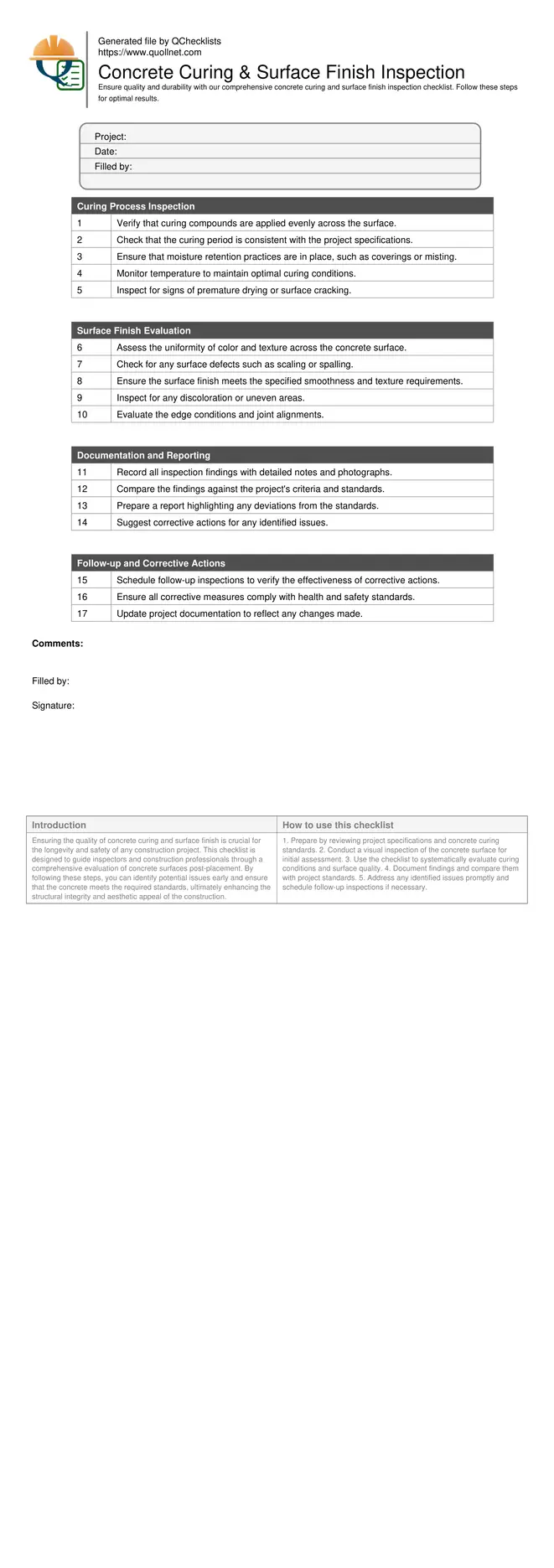Concrete Curing and Surface Finish Inspection Checklist
Ensuring the quality of concrete curing and surface finish is crucial for the longevity and safety of any construction project. This checklist is designed to guide inspectors and construction professionals through a comprehensive evaluation of concrete surfaces post-placement. By following these steps, you can identify potential issues early and ensure that the concrete meets the required standards, ultimately enhancing the structural integrity and aesthetic appeal of the construction.
- Ensure concrete curing meets industry standards to prevent premature cracking or durability issues.
- Inspect surface finishes for uniformity and compliance with project specifications.
- Identify potential surface defects such as scaling or discoloration early on.
- Facilitate quality assurance and compliance with construction codes.
- Enhance the lifespan and safety of concrete structures through diligent inspection.
Curing Process Inspection
Surface Finish Evaluation
Documentation and Reporting
Follow-up and Corrective Actions
Importance of Concrete Curing
Concrete curing is a critical process that helps in achieving the desired strength and durability of concrete. Proper curing prevents moisture loss from the surface, which can lead to surface shrinkage and cracking. It's essential to monitor the curing process closely to ensure that the concrete develops the required mechanical properties and durability.
- Maintain optimal moisture levels during curing.
- Prevent surface cracking through controlled curing.
- Enhance structural integrity with proper curing techniques.
Evaluating Surface Finish Quality
The quality of the concrete surface finish is a key indicator of the overall workmanship and attention to detail in a construction project. Inspectors should check for uniformity in color and texture, absence of surface defects, and compliance with design specifications. A high-quality finish not only enhances aesthetic appeal but also ensures better resistance to environmental factors.
- Check for uniform color and texture.
- Identify and address surface defects promptly.
- Ensure compliance with project specifications.
How to Use the Concrete Inspection Checklist
- Prepare by reviewing project specifications and concrete curing standards.
- Conduct a visual inspection of the concrete surface for initial assessment.
- Use the checklist to systematically evaluate curing conditions and surface quality.
- Document findings and compare them with project standards.
- Address any identified issues promptly and schedule follow-up inspections if necessary.
Call to Action
- Start Checklist Tick off tasks, leave comments on items or the whole form, and export your completed report to PDF or Excel—with a built-in QR code for authenticity.
- Download Excel - Concrete Curing and Surface Finish Inspection Checklist
- Download PDF - Concrete Curing and Surface Finish Inspection Checklist
- View Image - Concrete Curing and Surface Finish Inspection Checklist
